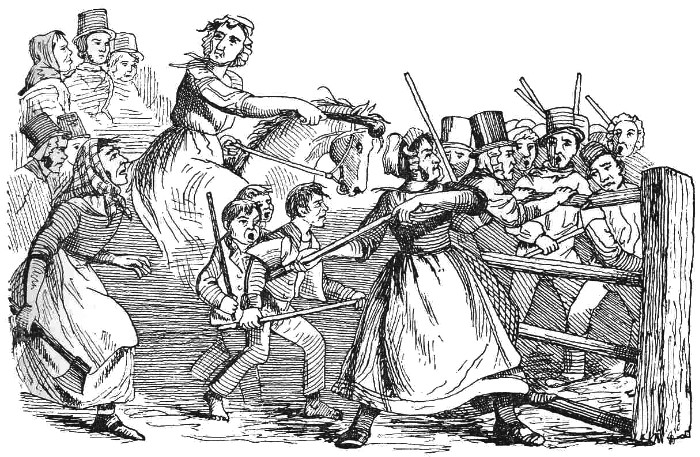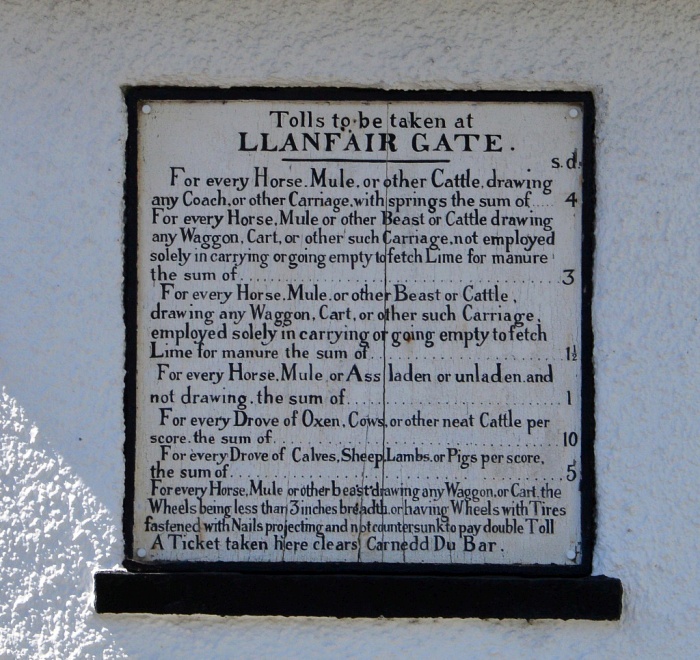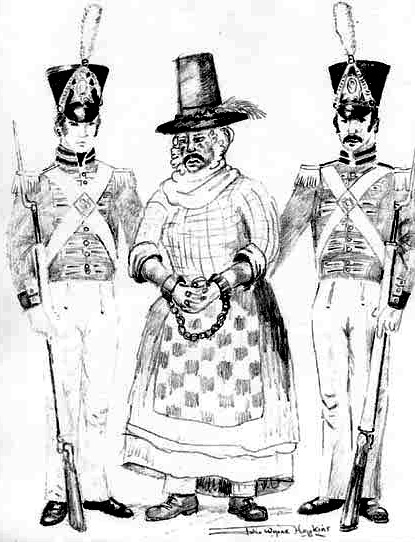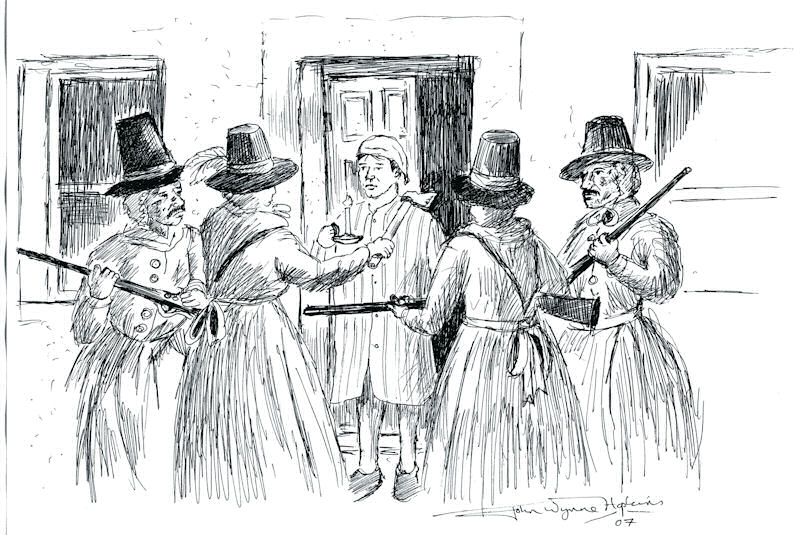Woodcut of a toll gate on the Islington turnpike road
|
|
“In July, 1749, a great body of the country people of the county of Somerset came to Bedminster, shouting prodigiously, so as to be heard at a long distance off, and proceeded to attack the turnpike gates and toll houses along the Ashton Road, with axes, hatchets, and other implements of destruction, so as entirely to demolish them in about half-an-hour. Cross bars and posts were immediately erected in their room, chains were put across the road, and some stout men were placed to assist the toll men; but the next day these also were attacked, and summarily destroyed by a mob of people; their shouts alarming the city, to which it was feared they would proceed, and commence an attack upon Newgate and rescue the prisoners, which they had threatened to do. Public notice was given to the people to prepare for their coming, and defend themselves; the rendezvous to be at the Exchange, on the alarm being given by fire-bells. The rioters, however, did not carry out their threat; two of them, named Perryman and Roach, were tried at the next Taunton assizes, found guilty, and executed at Ilchester.” A Popular History of Bristol, George Pryce FSA (1861) |
During the period 1839-43, there were further turnpike riots by tenant
farmers in west Wales protesting against the high
level of turnpike tolls. These were a big expense for small farmers, who
used the turnpikes to take their livestock and produce to market, and to
collect lime for use as a fertiliser (it could cost as much as five
shillings in tolls to move a cart of lime eight miles, at a time when an
agricultural labourer’s wage was about ten shillings a week).
Named the ‘Rebecca Riots’, the rioters were men disguised as women, calling
themselves ‘Rebecca and her daughters’ after the biblical passage in
which Rebecca talks of the need to “possess the gate of those who hate
them” (Genesis XXIV, verse 60). They attacked the toll-gates until the authorities
quelled the riots using troops and the force of the law. Some rioters
were
transported (Appendix).

A turnpike riot. Illustrated London News, 1843
Social conditions gradually changed over the decade. Improvements in the
laws controlling turnpike trusts and the coming of railway competition
eased many of the transport problems in the areas. People could move
more easily to find work, while the ending of the Corn Laws [7] and attempts
to moderate the Poor Law also helped.
The early part of the nineteenth century saw improvement in the
condition of the main
turnpike roads as the work of Telford and McAdam (see
Chapter 9) spread,
and in the progressive linking up of towns until most places of importance
were connected by stagecoach services. The improved roads then
being laid resulted in stagecoach speeds increasing from some 6 mph
(including stops) to 8 mph, [8] which greatly increased the level of
mobility for people and the mail. But despite the improvements
they had brought about, the
end of the turnpike era was approaching.
The turnpikes were undoubtedly damaged by the coming of the canals
in the later 18th and early 19th century, but to a great extent the
nature of their
businesses differed. Although some canals ran quick ‘fly boat’ services
for the conveyance of passengers and light goods, they were uncommon. The
canal carriers were mainly interested in transporting bulk cargoes ―
often long distance ― such coal,
stone/building materials and manure, to which road transport was not well suited, as remains the case. But
from the 1840s the new public railways became a major factor in the
financial failure of many turnpike trusts and, for that matter, canals.
Railways offered a far quicker and cheaper service with which neither
could compete. [9] This applied particularly to long-distance routes;
when a railway opened along a route served by stagecoaches, the coach operator(s)
quickly went
out of business, or had to convert to a railway feeder service.
By the early 1840s, many London-based mail coaches were being withdrawn,
the last being to close was the London to Norwich service in 1846. Regional mail coaches continued into the 1850s, but they too were
eventually replaced by rail services. The poet Thomas Cooper at
first lamented the demise of the mail coach, but having experienced the
improved speed and
comfort of rail travel, changed his tune:
|
I left the realm of silence by the Rail. From Paradise of Martyrs, by Thomas Cooper |
From the 1840s onwards, the steam-steeds’ arrival caused many
turnpike trusts to slip into insolvency, the outcome being that the cost
of road repair then fell on the
very ratepayers who were paying the tolls to use them. Thus, from 1864 onwards, Parliament embarked on a programme of
terminating turnpike trusts; any turnpike Act that had not already
expired, been repealed or discontinued, could continue to operate no
longer than 1st November 1886 unless Parliament declared otherwise.
The
last turnpike trust — that managing the Anglesey portion of the
Shrewsbury to Holyhead Road — expired on 1st November 1895.
And so ended the turnpike era. Under an Act of 1878 [10] a new class of
road emerged. All former turnpike roads that had become public
highways since 1870 were designated “main roads”, as were roads between
“great towns” and those leading to railway stations.
Thomas Telford’s attractive two-story toll
house at Llanfair PG, Anglesey. The Anglesey section of the A5 was
the last public toll road in Britain until the M6 toll motorway opened
in 2003. There were five toll gates, each with a toll house, at
approximately five mile intervals between the Menai Suspension Bridge
and Holyhead.

The principal weaknesses of the turnpike trusts lay in their financial
structure. From the outset the heavy capital debt incurred in their
creation had to be serviced, and by 1830 there were cases of unsuccessful
trusts that had not paid interest on their bonds for 50 years. A further
weakness lay in the absence of any central control over the trustees,
who were often slow to appoint efficient officers. The treasurer would
often keep toll receipts with his own money; there was little effective
control over the collectors, who were often illiterate and unable to
maintain accounts; and the process of mortgaging tolls was sometimes so
inefficient that there was little income left for road maintenance.
Ultimately, there was no practical method of holding a defaulting,
hopelessly incompetent or dishonest turnpike trust to account. Subject
to no official supervision or central control, under no inspection,
rendering no accounts, a trust could use or neglect its powers as it chose;
it could not even be prosecuted for letting its roads become
impassable!
Despite their failings, the turnpikes halted the deterioration in
the condition of main roads and slowly built up a network of reasonably
well maintained highways that allowed road transport to move more
quickly and reliably. In many cases the money raised by mortgaging toll
income allowed investment in road improvement, even in building
by-passes around bad sections of road. Although deadweight goods were
still carried more efficiently by water, until the advent of the public
railways road transport became the best means of carrying people, mail
and light goods rapidly between the booming towns of the Industrial
Revolution.
――――♦――――
THE UNTURNPIKED ROADS
The move towards a modern system of road maintenance developed
through the later nineteenth and early twentieth centuries as the result of a
series of Acts of Parliament that progressively shifted this
responsibility onto larger and more structured bodies.
The turnpike era reached its zenith around 1838, but there were in use
many more miles of unturnpiked roads;
|
“. . . . we might easily have imagined that by this time the bulk of the roads throughout the kingdom had become turnpikes, and that the condition of such byways and country lanes as still remained under the jurisdiction of the parish Surveyor of Highways was of no importance. This was not the case. Out of a total length of recognised public highway in 1820 of about 125,000 miles, only about 20,875 miles, or little over one-sixth, was under Turnpike Trusts; and even by 1838 the mileage under Trusts had only increased to about 22,000, leaving, it was computed, no less than 104,770 miles, with an annual expenditure of more than a million sterling, under parochial control . . . . Even across rural parishes, especially in the eastern counties and in the south-west of England, many roads of more than local importance remained outside the network of the eleven hundred Turnpike Trusts.” English Local Government: the History of the King’s Highway, Webb (1913) |
The administration of these thousands of miles of unturnpiked roads
continued much as in Tudor times, when the responsibility was
transferred from the manor to the parish. The numerous parishes and
townships around the land appointed an unpaid, unskilled (and possibly
illiterate and/or corrupt) Surveyor of Highways each year, who did what
he felt necessary using the forced statute labour unwillingly rendered
on the roads (often by the parish paupers) on the six appointed days
each year. The law also required parishioners to provide horses and carts,
according to their means, to assist with the work.
The 1835 Highways Act consolidated and amended existing highway law not
affecting the turnpike trusts. Some advances were made; the Act
abolished statute labour — in operation for some 300 years and never
that effective — replacing it with a levy on the parish, the ‘highway
rate’. The duties of the annually elected surveyor of highways became
remunerated, and he could be fined by the county justices for failing to
keep the highways in repair. Improvements in road engineering
permitted the abolition of regulations that limited the weights of loads
to be carried, and the construction of wagon and cart wheels.
But the Act’s weakness lay in confirming the parish as the principal
authority for repairing and maintaining unturnpiked roads. In reality, a
much larger geographical area, such as a county, was needed to
develop and deliver a strategic highways policy. The Act did permit two
or more parishes to apply to the justices to be united in a ‘highway
district’, having a salaried district surveyor, although each parish
remained responsible for its own assessment, rate collection and
expenditure. The supposed advantages that such amalgamation offered were the employment of
a more skilled person to supervise repairs, greater uniformity of
method, and greater efficiency in management; but the provision attracted little interest.
The move towards larger highway units began in 1862. Under the Highways
Act of that year, [11] the Justices of the Peace for a county were
authorised, by means of a provisional order confirmed by the Quarter
Sessions, to divide it compulsorily into a number of ‘Highway
Districts’, each consisting of a number of parishes. The
order listed the parishes to be grouped together, the name to be given
to the district, and the number of ‘way wardens’ to be elected by each.
The authority governing each Highway District was its ‘Highway Board’,
which comprised one or more members elected annually by each parish —
way-wardens — and any county justices residing in the district. It was to
appoint a treasurer, clerk and district surveyor, [12] whose salaries
and other administrative expenses were chargeable to a district fund to
which each parish contributed in proportion to the 3-year average spent
on maintaining its highways. Other changes regulating accountability and
audit followed in 1864.
The long-lived role of the parish in highway maintenance was now reduced
to that of electing a way-warden(s) and levying whatever highway rate was
sufficient to meet the precept of the Highway Board — at least that was
the theory. There was no compulsion for Highway Districts to be formed
and, by using a loophole in existing local government legislation, [13]
a parish could become an ‘Urban Sanitary Authority’, thereby retaining
control of its highways together with various public health matters,
such as providing clean drinking water, sewers, street cleaning, and
clearing slum housing. In this way many parishes continued to maintain
their own highways for some years to come.
In 1878, the Highways and Locomotives (Amendment) Act created a single
highway rate, thus preventing parishes being financially independent,
but it was not until 1894 that parishes were eliminated as highway
authorities altogether, thus ending a practice going back to the reign
of Henry VIII. [14] At the same time Urban Sanitary Authorities were
renamed Urban District Councils. In the meantime, the 1888 Local
Government Act transferred responsibility for major bridges and main
roads to the newly created County Councils. [15]
English highways were now administered, within boroughs or urban
district councils, by the town or district council; outside the urban
areas, main roads were the responsibility of the county council and the
others of the rural district council. The system of paid surveyors and
hired labour was now general, the cost being met out of local rates.
――――♦――――
APPENDIX.
TURNPIKE RIOTS
Reported in the CAMBRIAN, 16th Sept 1843.
THE PONTARDULAIS GATE.
(Extract from the report of Capt. Napier, Chief Constable.)
Just before we entered the village, I heard a noise, as if of a body of
men on the other side of the river. I also heard horns blowing, and a
great many guns fired off. I also heard a voice, like that of a woman,
crying out— “Come, come, come;” and a voice like the mewing of cats. This noise appeared to me to proceed from the direction of the Red Lion
Inn, which is at a short distance from the turnpike-gate. Immediately
after this, I heard a voice crying out aloud — “Gate!” and in a very
short time afterwards I heard a noise, as if the gate was being
destroyed. I then proceeded with my officers and men towards the gate,
and on coming in full view, I observed a number of men mounted on
horseback, and disguised. Some had white dresses on them, and others had
bonnets. Most of them appeared to be dressed like women, with their
faces blackened. A portion of the men were dismounted, and in the act of
breaking the gate and the toll-house. About three of them, who appeared
to lead, were mounted, having their horses’ heads facing the gate, and
their backs towards me. At this time there was a continual firing of
guns kept up by the parties assembled. I immediately called on my men to
fall in, and proceed towards the men who were on horseback, and who
appeared to be taking the lead, and called upon them, as loud as I
could, to “Stop.” I used the word “Stop,” three or four times. Upon
coming up to them, one of the mounted men, who was disguised as a woman,
turned round, and fired a pistol at me. I was close to him at the time. I moved on a few paces, and a volley was fired by the parties assembled
in the direction of the police. I should say the volley was fired at
us — that was the impression on my mind at the time. I then endeavoured to
take the parties, the three mounted men in particular, into custody.
Myself and men met with considerable resistance from them and the other
parties. The three men on horseback rode at us, as if they intended to
ride us down and get us out of the way.

The three prisoners, John Hughes, David Jones, and John Hugh, were among
the parties assembled on the occasion, and were taken into custody.
――――♦――――
DESTRUCTION BY FIRE OF HENDY TOLLHOUSE,
AND DEATH OF THE TOLL COLLECTOR.
A report reached this town on Sunday evening, that the above gate, as
well as the Toll-house, had been destroyed, and that the toll collector,
an old woman, had been shot dead.

On enquiry it turned out that the sad news was but too true. It appeared
that the gate-house was attacked by a party of the Rebaccaites at about
eleven or twelve o’clock on Saturday night. The number of persons
assembled could not have been great, as, according to the evidence of
one of the witnesses at the coroner’s inquisition, neither the noise of
horses nor the trampling of feet was heard, but two witnesses say that
they heard the reports of five or six gunshots. However, certain it is,
that soon after the house was fired, the collector, who appeared to be
in her usual state of health, went to the house of a neighbour, to seek
assistance, after which she returned to the toll-house, and as soon as
she went for the second time to the home of her neighbour, the
unoffending old woman sank and breathed her last. Further details will
be learnt from the inquest held on Tuesday, on the body of Sarah
Williams, toll collector, aged 75 years, before William Bonville, Esq.,
coroner.
――――♦――――
FOOTNOTES
1. An Act for the better repairing the Highway between Forn
Hill in the County of Bedford, and the Town of Stony-Stratford in the
County of Buckingham, 1706 (6 Anne c. 4).
2. Preservation of Roads Act, 1740 (14 Geo. II, c. 42). The long title
of this Act may have been An Act for Better Preservation of Turnpike
Roads, by limiting the Weight of Carriages, and erecting Weighing
Engines for that Purpose.
3. It was not until 1773 that a formal procedure was laid down by Act of
Parliament for auctioning the tolls (Turnpike Roads Act 13 Geo. III c.84 art. 31).
4. The cost of obtaining new legal powers — generally every 21-years —
placed a significant drain on a turnpike trust’s finances. The 1823
Sparrow’s Herne Act cost £409 to obtain, a not insignificant sum at a
time when a farm labourer’s wage was in the region of ten shillings a week.
5. Appendix B, The Turnpike Road System in England 1663-1840, William
Albert (1972).
6. See “Turnpike
Roads” and “Turnpikes
and tolls” at www.parliament.uk.
7. The Corn Laws were measures in force in the United Kingdom between
1815 and 1846 that imposed restrictions and tariffs on otherwise cheap
imported grain. They were designed to keep grain prices high to
favour domestic producers. Their effect was to enhanced the profits and
political power of the land owners at the expense of the poor, who were
faced with artificially high food prices, the price of grain (hence the
term ‘Corn Laws’) being central to the price of their most important
staple food, bread.
8. On the subject of road speeds during the 19th century, mention must be
made of an Act known to history as the ‘Red Flag Act’ (The Locomotive
Act 1865, 28 & 29 Vict., c. 83). By the 1860s there was concern that the
widespread use of steam road locomotives would endanger public safety.
It was also alleged — probably by those with business interests in
railways and horse-drawn carriages — that road locomotives damaged the
highway when being driven at the current speed limit of 10 mph. Despite
there being no evidence to support this claim, the most draconic speed restrictions
resulted. Under the Act, all road locomotives (which later included
automobiles) were restricted to a maximum of 4 mph in the country and 2
mph in the towns, and a man carrying a red flag was required to walk in
front of any hauling two or more wagons.
9. “The tolls from eight trusts along the London-Birmingham road, for
instance, fell from £29,000 to £15,800 immediately on the opening of the
London & Birmingham Railway [September, 1838]. By 1848 the
total receipts from all English turnpikes had fallen by a quarter.”
pp 120-121, An Economic History of Transport in Britain, Barker & Savage, 3rd edition, 1974
“Each stage-coach journeying daily from London to Manchester was
contributing over £1700 a year in turnpike tolls to the different Trusts
along the route. It was computed that each coach paid something
like £7 a year in tolls for each mile of road that it traversed.
The transfer of this business was instantaneous and complete.
Every coach had to be taken off the road the moment the railway was open to the towns along its route.
No one took a post chaise when he could take the train.”
p215, English Local Government: the History of the King’s Highway, Sidney and Beatrice Webb (1913)
10. The Highways and Locomotives (Amendment) Act 1878 (41 & 42 Vict., c.
77).
11. The Highways Act 1862 (25 & 26 Vict., c. 61).
12. As late as 1881, it was claimed in evidence that the Surveyors of
Highways, were:
“. . . . farmers, millers, clergymen, squires when they were not gardeners, bricklayers, broken-down clerks or shopkeepers, or merely the incompetent relations of prominent parishioners. ‘I do not suppose ten per cent are competent,’ said the witness, ‘although many are paid.’”
Quoted p210, English Local Government: the History of the King’s Highway, Sidney and Beatrice Webb (1913)
13. The Local Government Act, 1858 (21 & 22 Vict. c. 98).
14. The Local Government Act 1894 (56 & 57 Vict. c. 73). It was
estimated at the time that some 5,000 highway parishes continued to
elect their surveyor of highways each year, and mend their own roads.
15. County Councils were created by The Local Government Act 1888 (51 &
52 Vict. c. 41) to be responsible for more strategic services in a
region with, from 1894 — The Local Government Act 1894 (56 & 57 Vict. c.
73) — the smaller urban district and rural district councils being
responsible for other activities.
――――♦――――
[Next Page]
|
|